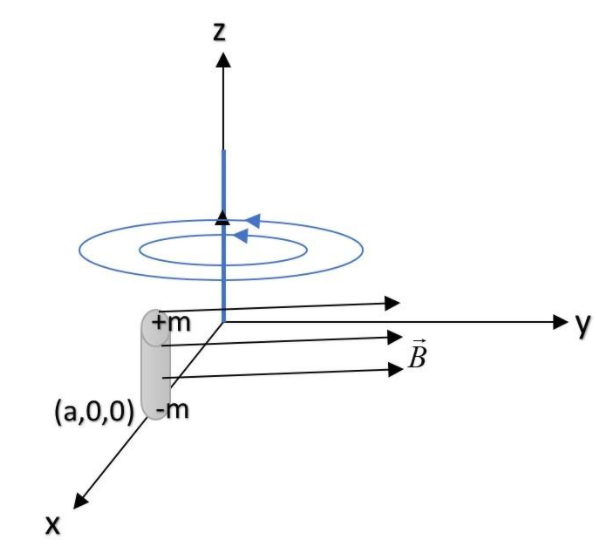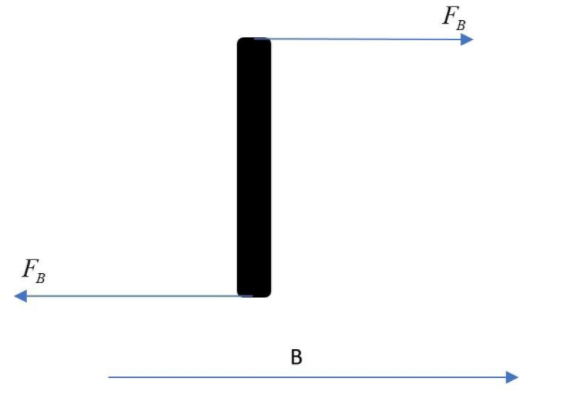
A tiny bar magnet is kept close to a long current carrying straight wire placed along the z-axis. When the center of the magnet is at (a,0,0) and it is oriented along the z-axis, it experiences:
A. no net force but a net torque.
B. neither net force nor net torque
C. both a net force and a net torque
D. a net force but no net torque.
Answer
573.9k+ views
Hint: When a current is passed through a wire, it produces a magnetic field around its region. This could be explained by the fact that a moving charge produces a magnetic and electric field around it. But since the wire is a conductor, hence there is no electric field outside the conductor due to the internal charges.
Complete step-by-step solution:
The situation as described in the question can be described by the following diagram:

The direction of the magnetic field can be obtained by using the right-hand rule, which states that:
Place your thumb in a direction pointing towards the flow of current and curl your fingers to close your palm. The direction of the curl will give the direction of the magnetic field at the point near the wire. In the above question, the direction of the magnetic field is as shown by $\vec B$ in the figure, parallel to the y-z plane and perpendicular to the x-axis.
Now, since the bar magnet has two poles of equal pole strength, hence they both will experience equal force but in the opposite direction, as shown by $F_B$ in the figure below.

Now, like a force in equal and opposite, hence net force is zero.
But as forces are being applied at two different points and in different directions, hence the net torque will not be zero.
Hence, option A. is correct.
Note: A force can only produce rotational moment (torque), only if the point of application is different from the hinge or other force. The system of forces, as described in the above problem is called ‘couple’. This is a system of forces in which equal and opposite forces act on a body in the opposite direction.
Complete step-by-step solution:
The situation as described in the question can be described by the following diagram:

The direction of the magnetic field can be obtained by using the right-hand rule, which states that:
Place your thumb in a direction pointing towards the flow of current and curl your fingers to close your palm. The direction of the curl will give the direction of the magnetic field at the point near the wire. In the above question, the direction of the magnetic field is as shown by $\vec B$ in the figure, parallel to the y-z plane and perpendicular to the x-axis.
Now, since the bar magnet has two poles of equal pole strength, hence they both will experience equal force but in the opposite direction, as shown by $F_B$ in the figure below.

Now, like a force in equal and opposite, hence net force is zero.
But as forces are being applied at two different points and in different directions, hence the net torque will not be zero.
Hence, option A. is correct.
Note: A force can only produce rotational moment (torque), only if the point of application is different from the hinge or other force. The system of forces, as described in the above problem is called ‘couple’. This is a system of forces in which equal and opposite forces act on a body in the opposite direction.
Recently Updated Pages
Master Class 12 English: Engaging Questions & Answers for Success

Master Class 12 Business Studies: Engaging Questions & Answers for Success

Master Class 12 Economics: Engaging Questions & Answers for Success

Master Class 12 Social Science: Engaging Questions & Answers for Success

Master Class 12 Maths: Engaging Questions & Answers for Success

Master Class 12 Chemistry: Engaging Questions & Answers for Success

Trending doubts
What are the major means of transport Explain each class 12 social science CBSE

Which are the Top 10 Largest Countries of the World?

Draw a labelled sketch of the human eye class 12 physics CBSE

Explain sex determination in humans with line diag class 12 biology CBSE

The pH of the pancreatic juice is A 64 B 86 C 120 D class 12 biology CBSE

Explain sex determination in humans with the help of class 12 biology CBSE




